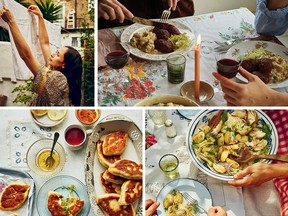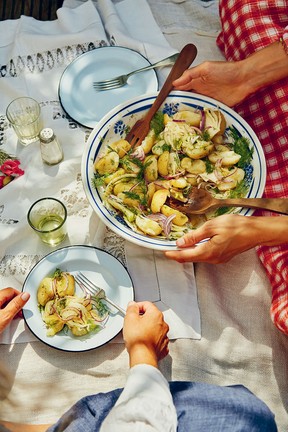Make Alissa Timoshkina’s spring picnic recipes for fennel and potato salad, rye, beet and beef meatballs and piroshki buns

Article content
Our cookbook of the week is Kapusta: Vegetable-Forward Recipes from Eastern Europe by Alissa Timoshkina, a London-based writer, historian, cooking teacher and co-founder of #CookForUkraine.
Jump to the recipes: fennel and potato salad with mustard and dill; rye, beet and beef meatballs with coriander and gherkins; and piroshki buns with cabbage, spring onion and hard-boiled eggs.
Advertisement 2
Article content
Alissa Timoshkina is giving the cabbage its due. The London-based food writer and historian specializes in Eastern Europe, and her second cookbook, Kapusta (Quadrille, 2025), is an ode to the hardy and versatile vegetable and other ingredients at the heart of the region’s cuisines.
With chef and food writer Olia Hercules, Timoshkina founded the #CookForUkraine campaign, which has raised more than $4.5 million since the invasion began.
“It’s been a very deeply felt experience, and it’s heartbreaking, but it has also brought to the fore just how important food is and how people tend to dismiss food in a bigger conversation about culture and politics, especially. But it’s actually a huge factor that not only by studying food, you can gain such an amazing insight into, and a better understanding, hopefully, of different cultures. But also, it’s a tool with which you can advocate for political and social change. And it’s been incredible to be able to use food in a slightly different way. I’ve never done anything like that before.”
Advertisement 3
Article content
Timoshkina is originally from Siberia and has Ukrainian-Jewish heritage, which informs her approach to cooking. She was working on her second book, charting a culinary journey on the Trans-Siberian Express, when Russia invaded Ukraine in February 2022. The fundraising campaign helped her find a new direction.
“Since 2022, I’ve been immersed in what was happening — and still is. And through #CookForUkraine, I’ve been exposed to so many wonderful people and so many amazing dishes.”
Timoshkina felt there was a lot of confusion about Eastern Europe, both geographically and culturally. Kapusta allowed her to address some of these misconceptions and elaborate on what she’s learned over the past three years.
Article content
Advertisement 4
Article content
Kapusta means “cabbage” in many Slavic languages. Timoshkina initially wanted to write a book on cabbage alone because it “felt like such a powerful symbol of Eastern European resilience and quite a quirky way of turning the stereotype around.” But she expanded her view to include four other foundational vegetables that are “accessible, very simple, inexpensive” — beet, potato, carrot and mushrooms — and additional chapters on dumplings, pickles and ferments.
“Pretty much every vegetable mentioned in the book is a local vegetable to so many countries. And I hope that people will feel an immediate connection to it. And it’s quite fun to give people new ideas of how to cook with these familiar things you have in your kitchen anyway.”
Advertisement 5
Article content
What drew Timoshkina to the idea of writing about vegetable-forward recipes and fermented flavours in Kapusta was that it didn’t chase current Western trends but showcased techniques and recipes that have existed for centuries in Eastern Europe.

As well-versed as Timoshkina is in Eastern European cuisine, she also went on a journey of discovery. Even something as “iconic, politically charged and humble” as borscht, which she grew up with, offered new insights. Through #CookForUkraine, Timoshkina learned that it’s much more than the dish itself, but the culture of making it and its ties to seasonality and regionality.
“There are strong ideological ties around borscht in Russia, especially now in the current context. And then learning the sheer diversity and variety of techniques and recipes that exist in Ukraine was just mind-blowing. And of course, rightly so, UNESCO granted the status (by adding it to the list of heritage traditions “in need of urgent safeguarding“) because it really is a cultural phenomenon of making borscht.”
Advertisement 6
Article content
Delving into the cuisines of ethnic minorities, including Romani and Tatars, was part of her learning process, as was rediscovering the cuisine of the Ashkenazi diaspora. She went closer to her roots and created new connections she didn’t know existed.
“Growing up in the Soviet Union, that identity was so complex and so fragmented that certain dishes I knew well, and I grew up with them, I didn’t actually realize that they were an iconic part of Ashkenazi cuisine.”
Timoshkina notes that some recipes transcend the category of mere dishes — they’re entire genres. “Cabbage rolls are a really beautiful example. They technically exist in pretty much any cuisine globally, not just in Eastern Europe,” she says, laughing. “But if you go into the Eastern European regional map, then you can see how the particular flavouring of the same dish develops, depending on where you are.”
Advertisement 7
Article content
Transylvania is the regional “home of the dish,” she adds. There’s even a cabbage festival there, where people from different villages come together and vie for the title of best cabbage roll.
In Kapusta, Timoshkina set out to convey a sense of ease in the recipes and the warmth of an average Eastern European household. Contrary to the stereotype of a “poverty-stricken” cuisine, she says you’ll likely experience a welcoming gathering around the table when invited to dinner. “There’s a real sense of hospitality and this love of sharing and almost overfeeding. And I hope that kind of warmth comes through, as well as the accessibility of the warmth of the dishes themselves.”
When Timoshkina looks back at some of the recipes in her cookbook debut, Salt & Time (Interlink Books, 2019), she sees herself navigating an inferiority complex around the perceived bleakness of Russian cuisine. Now, she recognizes ways she could have made them more straightforward.
Advertisement 8
Article content
“So, with this book, I wanted to strip down to the most accessible, honest way of cooking things. There are some alterations, where I add my own touch to it, but most of the time, it’s taking the recipe that’s been around for a long time, and it’s been tried and tested by generations, and just showing people how delightful and how simple it is.”
Recommended from Editorial
FENNEL AND POTATO SALAD WITH MUSTARD AND DILL

Serves: 4
500 g (1 lb 2 oz) new potatoes
1 large fennel bulb
1 red onion
2 tbsp apple cider vinegar
Salt and black pepper to taste
For the dressing:
50 mL (3 1/2 tbsp) unrefined sunflower oil
1 tbsp honey
1 tbsp wholegrain mustard
1 tbsp Dijon mustard
1 tbsp apple cider vinegar, or to taste
25 g (1 oz) dill, roughly chopped
Advertisement 9
Article content
Step 1
Cook the potatoes in salted water for 30 minutes, or until cooked through but firm. Drain the potatoes and let them cool down before cutting each in half lengthways.
Step 2
Thinly slice the fennel and the red onion on a mandoline. Place in a bowl and toss with the vinegar and a pinch of salt.
Step 3
Make the dressing by mixing the oil, honey, mustard and vinegar. Season the dressing to taste.
Step 4
Add the potatoes to the bowl with the fennel and onions, throw in the dill, pour in the dressing and give everything a good mix.
RYE, BEET AND BEEF MEATBALLS WITH CORIANDER AND GHERKINS

Makes: 20
400 g (14 oz) ground beef
2 raw beets (weighing approx. 250 g/9 oz), peeled and grated
4 garlic cloves, finely chopped
2 gherkins (dill pickles), grated
2 eggs
1 large slice of rye bread (60 g/2 oz), soaked in beef stock for 1 minute, then squeezed
4 heaped tbsp chopped dill
2 tbsp ground coriander
Generous pinch of salt and black pepper
Vegetable oil, for shallow-frying
Slaw and mustard or horseradish sauce, or tovchanka (Ukrainian potato and bean mash, the recipe is in the book), to serve
Advertisement 10
Article content
Step 1
In a large bowl, thoroughly mix all the ingredients together with your hands.
Step 2
Shape the mixture into small, slightly flattened balls, around 50 g (1 3/4 oz). (You may prefer to make them bigger, and use them as burger patties.)
Step 3
To fry the meatballs, heat enough oil (4-6 tablespoons) for shallow-frying over medium heat (the exact amount of oil will depend on the size of the pan). Fry in batches over medium heat for 10 minutes, turning occasionally so they are browned on all sides.
Step 4
Serve with a slaw on the side and some mustard or horseradish sauce for dipping. Or you can (and should) up your ‘meatballs and mash’ game to the next level by serving these with tovchanka.
PIROSHKI BUNS WITH CABBAGE, SPRING ONION AND HARD-BOILED EGGS
Advertisement 11
Article content

Makes: 20-25
1 tsp dried yeast
50 mL (3 1/2 tbsp) warm water
1 tsp sugar
250 mL (1 cup) warm milk
1 egg
1 tsp salt
1 tbsp vegetable oil
500 g (1 lb 2 oz/roughly 4 cups) all-purpose flour, plus more for dusting
For the filling:
Vegetable oil, for shallow frying
500 g (1 lb 2 oz) white cabbage, thinly shredded
1 medium bunch of spring onions (green onions), thinly sliced
100 g (1 scant stick) salted butter
1 bunch of dill, finely chopped
4 eggs, hard-boiled
Salt and black pepper
Step 1
To make the dough, mix the dried yeast, warm water, sugar and 50 mL (3 1/2 tablespoons) of milk in a cup, and let it rest in a warm place for 5-10 minutes or until the mixture starts to bubble. In a large bowl, whisk together the rest of the milk, egg, salt, oil and the yeast mixture until you get a smooth, frothy liquid.
Advertisement 12
Article content
Step 2
Start adding the flour in batches, whisking constantly to ensure there are no lumps. Once the whisk starts getting stuck in the dough, continue mixing with your hands. Eventually the dough should stop sticking to your hands. But if not, you can always add more flour at a later stage. Once you have incorporated all the flour, cover the bowl with plastic wrap and let it rest for 1 hour or until it has doubled in size. In the meantime, prepare the filling.
Step 3
Heat the oil in a large frying pan or a Dutch oven. Fry the cabbage with the spring onion, stirring occasionally over medium heat for 10-15 minutes, until still crunchy but slightly caramelized.
Step 4
Take off the heat, add the butter, the dill and the chopped hard-boiled eggs, and season generously with salt and black pepper. Let it cool down.
Advertisement 13
Article content
Step 5
Now, let’s get back to the dough. Once it has doubled in size, tip it out onto a work surface generously dusted with flour. Divide the dough in half and cover one half with a tea towel or plastic wrap to prevent it from drying while you knead the other. Work the dough for a few minutes, adding more flour, if needed, as you go along.
Step 6
Divide the dough into small chunks, around 45 g (1 1/2 oz) each, and pat them out into round discs 8-10 cm (3 1/4-4 in) in diameter. Add 2 tablespoons of filling to each disc and seal the edges by lifting them towards the middle. Try to distribute the filling as evenly throughout as you can. Flatten each bun slightly, lay them out on a dusted tray or parchment paper and cover with plastic wrap, while you finish the rest.
Advertisement 14
Article content
Step 7
To fry the buns, set a frying pan over a medium heat and heat enough oil for shallow-frying (4-6 tablespoons, depending on the size of your pan; you might need to keep adding more, as the buns will absorb a lot). Fry the buns in small batches (3-4) on each side for 3 minutes. Remove and let rest on some paper towels to absorb excess oil, then serve immediately with some black tea with honey and lemon.
Recipes and images excerpted with permission from Kapusta by Alissa Timoshkina published by Quadrille Publishing, February 2025, RRP $63.50 Hardcover.
Our website is the place for the latest breaking news, exclusive scoops, longreads and provocative commentary. Please bookmark nationalpost.com and sign up for our cookbook and recipe newsletter, Cook This, here.
Article content






